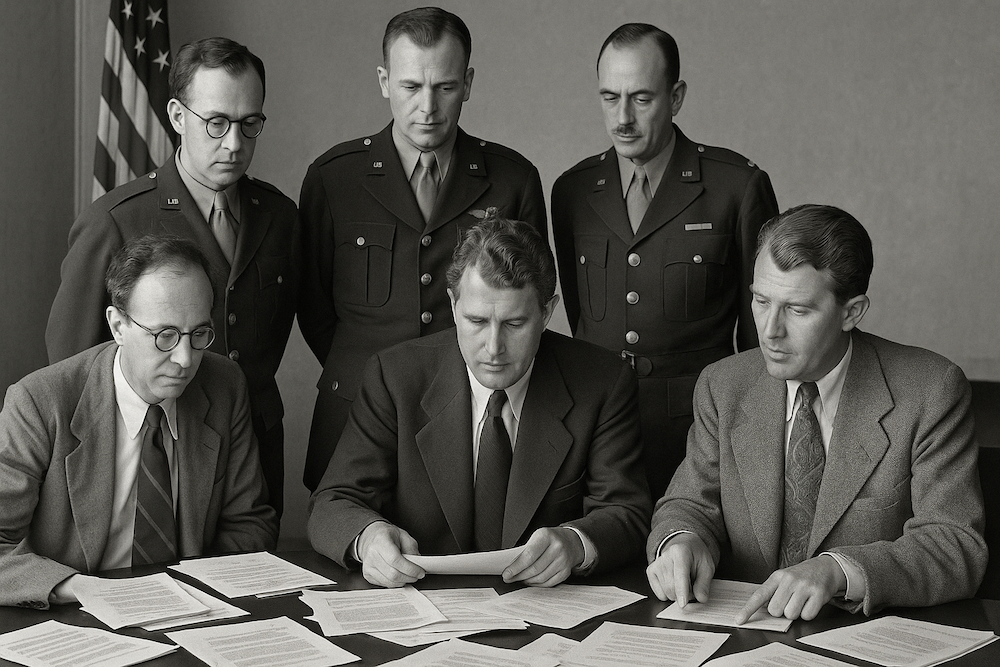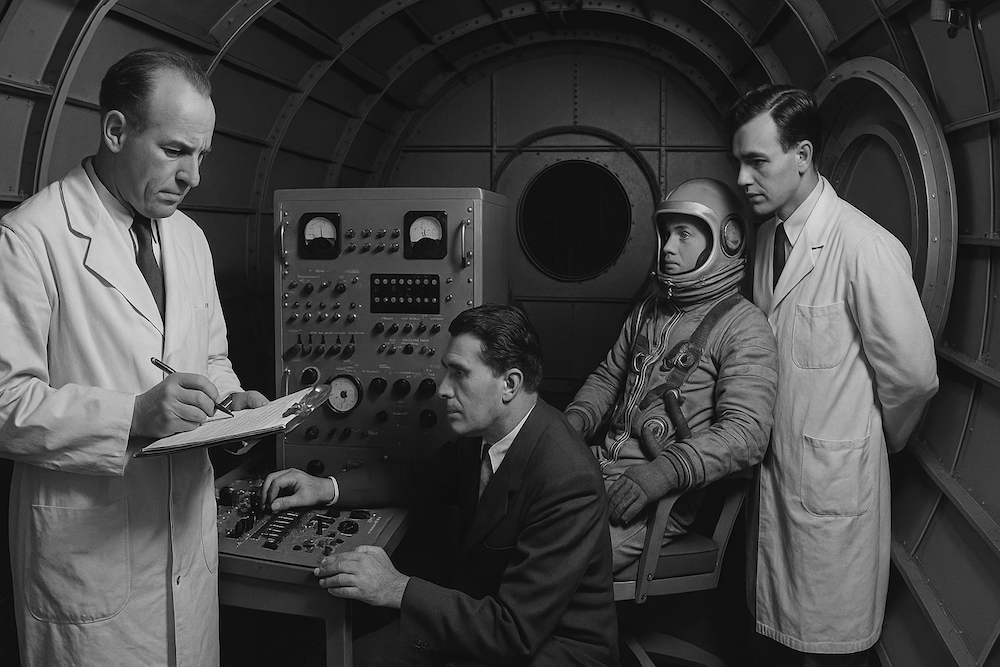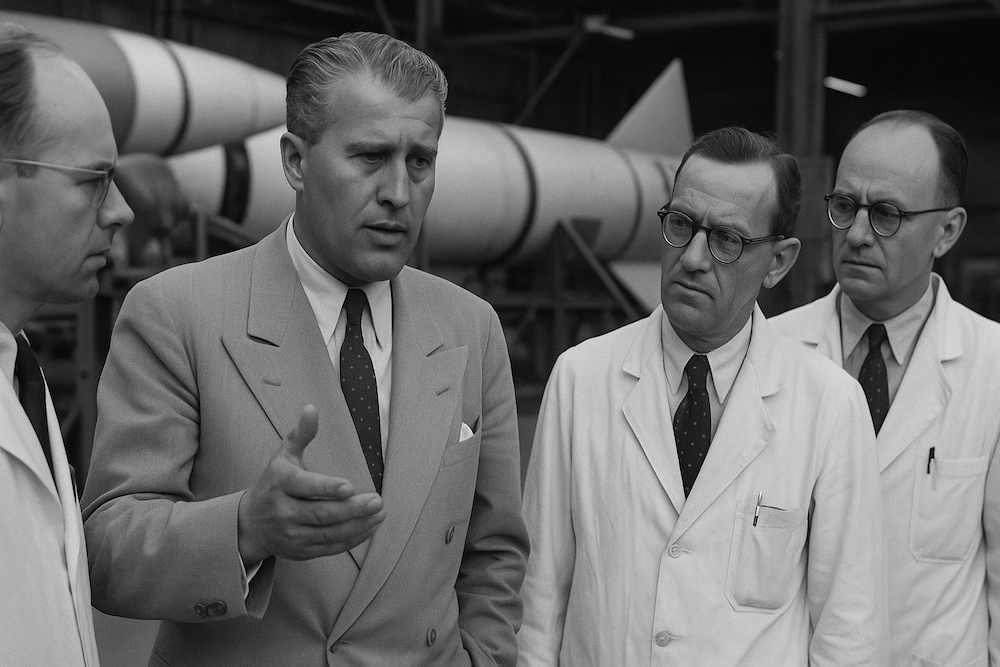In the final months of World War II, as Allied forces advanced through Nazi Germany, American military officials launched a covert mission that would reshape the trajectory of science, technology, and ethics for decades to come. Operation Paperclip, a secret intelligence program that brought more than 1,600 German scientists, engineers, and technicians to the United States, remains one of the most controversial chapters in American history. Among these recruits were not merely talented scientists, but former members of the Nazi Party, including some who had participated in or overseen programs that relied on slave labor and human experimentation.

The story of Operation Paperclip raises profound questions that continue to resonate today. How far should a nation go in the pursuit of technological advantage? Can scientific achievement justify overlooking moral crimes? And what happens when the quest for national security collides with the demands of justice?
The Genesis of a Morally Ambiguous Program
Operation Paperclip did not emerge from a vacuum. Its origins lie in the shifting geopolitical landscape of 1945, as World War II drew to a close and the contours of a new conflict began to take shape. The United States and the Soviet Union, wartime allies bound by a common enemy, were rapidly becoming adversaries. American officials recognized that the looming Cold War would be decided not just by military might, but by technological superiority.
Germany's wartime research programs had produced remarkable, if terrifying, innovations. The V-2 rocket, the world's first long-range guided ballistic missile, had terrorized London and Antwerp in the final months of the war. German scientists had pioneered jet propulsion, advanced aerodynamics, and chemical weapons technology. The United States feared that if these scientific minds fell into Soviet hands, the balance of power would shift decisively against American interests.
The Combined Intelligence Objectives Subcommittee, created by British and American forces, began identifying German scientists and technicians whose expertise could prove valuable. In July 1945, the Joint Chiefs of Staff officially established Operation Overcast, later renamed Operation Paperclip in November of that year. The name derived from an administrative detail with profound symbolic weight. Paperclips were used to attach sanitized biographical profiles to personnel files, effectively obscuring the Nazi affiliations and war crimes of many recruits.
The Whitewashing Machine
President Harry Truman officially sanctioned Operation Paperclip in September 1946, but with a crucial caveat. His directive explicitly forbade the recruitment of anyone who had been a member of the Nazi Party or an active supporter of Nazi militarism. This restriction, however, would prove to be more of a suggestion than a rule.
The Joint Intelligence Objectives Agency, the organization directly responsible for Operation Paperclip, faced a dilemma. Many of the most valuable German scientists were deeply embedded in the Nazi regime. To exclude them would undermine the program's strategic objectives. The solution was as simple as it was ethically troubling. JIOA officials systematically falsified professional and political biographies, removed evidence of Nazi Party membership from personnel files, and created entirely new histories for scientists deemed too valuable to lose.

This bureaucratic sanitization went beyond mere paperwork. Military intelligence officers rewrote dossiers, omitting or downplaying participation in war crimes. Background checks that should have disqualified candidates were conducted with deliberate superficiality. When State Department representative Samuel Klaus demanded more thorough investigations, he was seen as an obstruction and eventually sidelined. The imperative of Cold War competition had eclipsed the demands of justice and accountability.
The extent of this cover-up was extraordinary. Documents were destroyed, records were altered, and testimonies were manipulated. German scientists who arrived in the United States found themselves with clean slates, their pasts conveniently erased by the same government that had fought to defeat Nazism. The irony was not lost on critics at the time, including prominent figures like Eleanor Roosevelt and Albert Einstein, who vocally opposed the program.
The Human Cost of Innovation
The moral cost of Operation Paperclip becomes starkest when examining the dark history behind Germany's wartime technological achievements. The V-2 rocket program, which would become the foundation of American space exploration, was built on a foundation of unspeakable suffering. Production of the V-2 took place at the Mittelwerk underground factory in central Germany, part of the Mittelbau-Dora concentration camp complex.
More than 60,000 prisoners were sent to this facility between 1943 and 1945. They worked in horrific conditions, mining tunnels through mountains, assembling rockets in damp, freezing underground chambers with inadequate food, water, or sanitation. The mortality rate was staggering. Historians estimate that between 20,000 and 25,000 prisoners died at Mittelbau-Dora, many from starvation, disease, exhaustion, and brutal treatment by guards.
The arithmetic is chilling. The V-2 rocket killed approximately 5,000 people when deployed against Allied targets. But more than twice that number died producing the weapon. The rocket became unique in military history as a weapon that killed more people in its manufacture than in its deployment.
Wernher von Braun, the charismatic rocket scientist who would become the face of America's space program, was intimately connected to this suffering. As technical director of the V-2 program, he visited Mittelwerk at least a dozen times. Former prisoners testified that von Braun was present at executions of workers accused of sabotage, and that he personally selected concentration camp prisoners for rocket production. Von Braun later claimed he was powerless to change the situation, but the evidence suggests a man who was at minimum complicit in, and at worst directly responsible for, the exploitation of slave labor.
Arthur Rudolph, who managed the Saturn V program that would take Americans to the moon, served as operations director for V-2 production at Mittelwerk. He witnessed and approved reports of sabotage that led to public executions of prisoners. In 1984, facing investigation by the Justice Department's Office of Special Investigations, Rudolph renounced his American citizenship and left the country to avoid prosecution. He had lived and worked in the United States for nearly four decades, honored as a hero of the space program, before his past finally caught up with him.

The medical scientists recruited through Operation Paperclip brought their own troubling histories. Hubertus Strughold, known as the "Father of Space Medicine" for his pioneering work on space suits and life support systems, had overseen the Institute for Aviation Medicine in Nazi Germany. Evidence emerged linking his institute to cruel experiments on concentration camp prisoners, including oxygen deprivation tests on epileptic children taken from a euthanasia center. Despite multiple investigations, Strughold was never charged, and he continued his work in the United States until his death in 1986. Only posthumously was his legacy seriously questioned, leading to the retirement of prestigious awards that had borne his name.
The Architects of America's Space Program
Despite their troubling pasts, the German scientists brought to America through Operation Paperclip made undeniable contributions to American technology and the space program. The question is not whether they were talented, but whether their talents justified the moral compromise of overlooking their crimes.
Wernher von Braun became the most visible face of this Faustian bargain. Arriving in the United States in 1945, he initially worked at White Sands Proving Ground in New Mexico, testing captured V-2 rockets. In 1950, his team moved to Redstone Arsenal in Huntsville, Alabama, where they developed the Redstone rocket, America's first nuclear-armed ballistic missile. Von Braun became a public figure, appearing on television shows and writing popular articles about space exploration. He cultivated an image as an idealistic dreamer, a man whose sole passion was reaching the stars.
In 1960, von Braun's division was transferred to NASA, and he became the first director of the Marshall Space Flight Center. Under his leadership, the center developed the Saturn V rocket, the most powerful launch vehicle ever successfully deployed. On July 20, 1969, the Saturn V carried the Apollo 11 mission to the moon, fulfilling President Kennedy's challenge to land a man on the lunar surface before the decade ended. It was a triumph of engineering, a moment of national pride, and the culmination of von Braun's lifelong dream. But the shadow of Mittelbau-Dora never entirely disappeared.
Throughout his career in America, von Braun carefully managed his public image, downplaying his Nazi affiliations and distancing himself from the slave labor that built his rockets. When West German authorities asked him to testify in a war crimes trial in 1968, he was deeply concerned that the publicity would damage his reputation and NASA's image. His testimony was carefully calibrated to minimize his responsibility.
Other Paperclip scientists made similarly significant contributions. Kurt Debus, an ardent Nazi who had joined the party in 1935, became the first director of NASA's Kennedy Space Center. Hubertus Strughold developed technologies that enabled human spaceflight. Engineers who had designed Germany's jet aircraft helped advance American aviation. Chemists who had worked on synthetic fuels and chemical weapons brought their expertise to American industry and defense.
The collective value of German scientific knowledge transferred to the United States has been estimated at ten billion dollars in patents and industrial processes. The question remains whether this technological windfall was worth the moral price.
The Coverup Unravels
For decades, Operation Paperclip remained largely hidden from public scrutiny. The scientists who arrived in America settled into new lives, became American citizens, raised families, and were celebrated as contributors to national progress. Their German accents and European mannerisms were seen as charming quirks, not reminders of a darker past.
But truth has a way of surfacing. In the 1970s and 1980s, investigative journalists began uncovering the details of Operation Paperclip and the sanitized backgrounds of its participants. Journalist Linda Hunt, working for CNN's investigative unit, played a crucial role in exposing the extent to which German scientists' Nazi pasts had been deliberately obscured. Her work revealed that at least fifteen of the twenty-one prominent scientists she investigated had been active Nazi Party members, ten had served in paramilitary organizations like the SS or SA, and six had been tried at Nuremberg.
In 1979, the Justice Department established the Office of Special Investigations with a mandate to find and prosecute Nazi war criminals living in the United States. While the OSI did not bring criminal charges against any Operation Paperclip scientists directly, its investigations led to several notable departures from the country. Arthur Rudolph's case was the most prominent. Georg Rickhey, who had managed the Mittelwerk factory, was extradited to Germany in 1947 for war crimes trials, though he was ultimately acquitted.
Congressional hearings in the 1970s concluded that American military leaders had made morally bankrupt decisions in the name of national security. The testimony revealed the extent of the deception, the deliberate falsification of records, and the knowing recruitment of individuals who should have faced justice at Nuremberg. The hearings did not result in criminal prosecutions, but they permanently stained Operation Paperclip's legacy.
The Ethical Calculus
Defenders of Operation Paperclip argue that the program was a strategic necessity. Without German scientific expertise, they contend, the United States might have lost the technological race with the Soviet Union. The Cold War could have ended very differently if Soviet scientists had gained access to Germany's rocket technology and aerospace innovations. From this perspective, Operation Paperclip was a regrettable but pragmatic decision made in extraordinary circumstances.
This argument, however, raises difficult questions. If technological advantage justifies overlooking war crimes, where does that logic end? What other moral lines can be crossed in the name of national security? And does the fact that the Soviet Union was also recruiting German scientists make America's actions more defensible or simply prove that both superpowers were willing to compromise their values?
Critics point out that Operation Paperclip did more than recruit scientific talent. It rewarded individuals who had participated in crimes against humanity. While Holocaust survivors struggled to gain entry to the United States, facing stringent immigration quotas and bureaucratic obstacles, Nazi scientists were welcomed with open arms, given excellent jobs, granted citizenship, and publicly celebrated. The message sent was clear: useful expertise could wash away even the most heinous crimes.
The program also raises questions about the actual necessity of these scientists. Some historians argue that von Braun and his team accelerated American rocket development by perhaps a few years, but that American scientists would have reached similar conclusions independently. The atomic bomb, after all, was developed without German assistance. The question becomes whether a few years of technological advantage justified compromising on accountability for war crimes.
Legacy and Lessons
The impact of Operation Paperclip extends far beyond the scientists it brought to America. The program established a precedent for prioritizing strategic interests over moral accountability, a pattern that would repeat throughout the Cold War. The same logic that justified recruiting Nazi scientists would later justify supporting authoritarian regimes, overlooking human rights abuses by allies, and pursuing covert operations that violated international law.
The scientists of Operation Paperclip achieved remarkable things in their adopted country. The Saturn V rocket remains an engineering marvel. The technologies developed for space exploration have produced countless civilian applications. The knowledge gained has advanced human understanding of the universe. But these achievements are forever tainted by the circumstances of their genesis.
Today, memorials and museums acknowledge the suffering of those who built the V-2 rockets. The Mittelbau-Dora concentration camp is preserved as a site of memory and education. Awards named after Strughold and other controversial figures have been retired. There is a growing recognition that the story of space exploration must include the story of those who died to make it possible.
The legacy of Operation Paperclip forces us to confront uncomfortable truths about the relationship between science and ethics, between national interest and moral responsibility, between achievement and accountability. It reminds us that technological progress is not ethically neutral, that the means by which knowledge is gained matters, and that some bargains, no matter how strategically advantageous, carry costs that can never be fully calculated or justified.
The German scientists brought to America under Operation Paperclip were neither pure villains nor innocent victims of circumstance. They were individuals who made choices, who prioritized their careers and research over the suffering of others, and who accepted the opportunities offered by the American government to start new lives unburdened by their pasts. Some may have felt genuine remorse; others appeared to feel none. But all of them benefited from a system that valued their knowledge more than it valued justice.
Operation Paperclip succeeded in its immediate goals. It denied valuable scientific talent to the Soviet Union, accelerated American weapons development, and contributed to the successful moon landing. But it also compromised American values, rewarded individuals who should have faced prosecution, and established patterns of ethical compromise that would haunt American foreign policy for generations. The question it leaves us with is not whether the program worked, but whether any strategic goal can justify abandoning the principles of justice and accountability that define a democratic society.
References
- Jacobsen, Annie. "Operation Paperclip: The Secret Intelligence Program That Brought Nazi Scientists to America" (Little, Brown and Company, 2014)
- National Archives and Records Administration: Joint Intelligence Objectives Agency Records (RG 330)
- Neufeld, Michael J. "Von Braun: Dreamer of Space, Engineer of War" (Knopf, 2007)
- Neufeld, Michael J. "The Rocket and the Reich: Peenemünde and the Coming of the Ballistic Missile Era" (Harvard University Press, 1995)
- National Geographic: "How Operation Paperclip brought Nazi scientists to the U.S." (2025)
- National WWII Museum: Interview with Dr. Michael Neufeld on Wernher von Braun and the Nazi Rocket Program
- Smithsonian National Air and Space Museum: "Project Paperclip and American Rocketry after World War II"
- PBS American Experience: "Wernher von Braun and the Nazis"
- NASA Historical Archives: Records on German rocket scientists and Operation Paperclip
- United States Holocaust Memorial Museum: Documentation on Mittelbau-Dora concentration camp
- University of Alabama Huntsville: "Dora and the V-2: Slave Labor in the Space Age" exhibit materials
- Hunt, Linda. "Secret Agenda: The United States Government, Nazi Scientists, and Project Paperclip, 1945 to 1990" (St. Martin's Press, 1991)
- Office of Special Investigations: Declassified documents on Nazi war crimes investigations
- Britannica: "Operation Paperclip" encyclopedic entry
- History.com: "What Was Operation Paperclip?" historical analysis
- Various CIA declassified documents on Operation Paperclip personnel
- Academic journals and historical reviews on postwar German scientist recruitment programs
